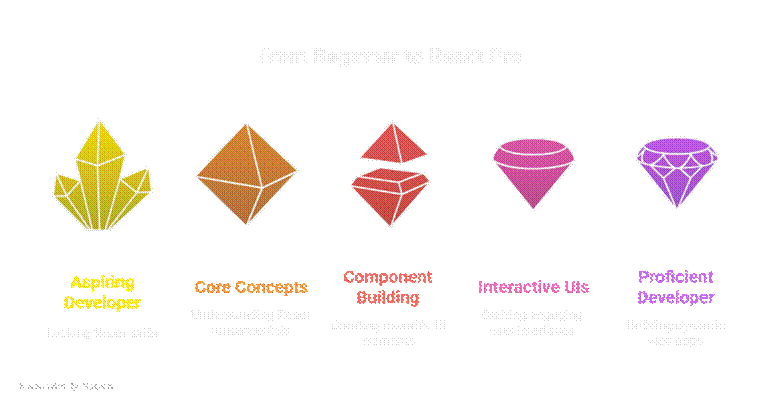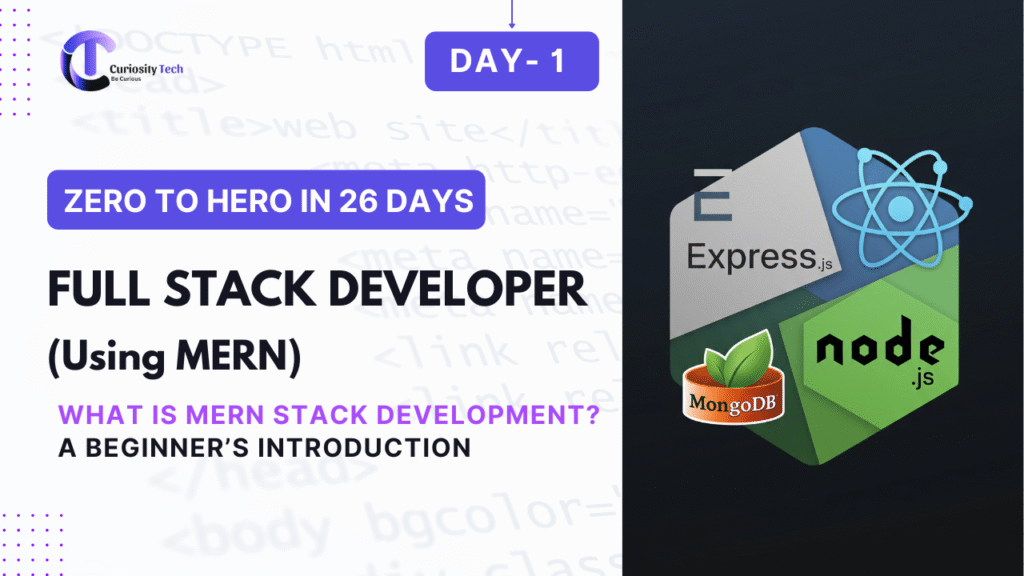Frontend development has evolved tremendously over the years, moving from static HTML pages to dynamic, interactive web applications. Among the most influential tools enabling this transformation is React.js, a powerful JavaScript library that simplifies building modern user interfaces. Whether you are a budding frontend developer or an experienced UI/UX professional, understanding React.js is crucial to staying ahead in 2025’s fast-paced digital ecosystem.
At CuriosityTech.in, we empower developers to master modern frontend technologies through hands-on projects, tutorials, and workshops, ensuring every learner can create responsive, interactive, and visually appealing web applications.
What is React.js?
React.js is an open-source JavaScript library created by Facebook for building fast, scalable, and maintainable user interfaces. Unlike traditional approaches, React allows developers to build reusable components that can manage their own state, making it easier to design complex UIs without rewriting code repeatedly.
Key Features of React.js:
| Feature | Description |
| Component-Based | Build encapsulated components that manage their own state and compose them to create complex UIs. |
| Declarative | React automatically updates and renders components efficiently when data changes, making code predictable. |
| Virtual DOM | React uses a virtual DOM to optimize updates, improving app performance. |
| JSX Syntax | Allows HTML-like syntax in JavaScript, making UI code intuitive and readable. |
Why React.js is Essential for Frontend UI Development
- Reusability of Components: Create small, reusable components like buttons, modals, or form elements. This reduces repetitive coding and makes maintenance easier.
- High Performance: React’s virtual DOM minimizes costly DOM manipulations, ensuring smooth user experiences even for complex interfaces.
- Strong Ecosystem: With tools like React Router for routing, Redux for state management, and a thriving community, React offers everything a frontend developer needs.
- Future-Proof Skills: Many tech giants, startups, and agencies rely on React for web and mobile apps, making it a highly valuable skill in the job market.
At CuriosityTech.in, our training emphasizes hands-on React projects, allowing learners to experience real-world application development while building a robust portfolio.
React.js Architecture: Hierarchical Overview
Here’s a simple component hierarchy example for a typical React web app:
| Component | Sub-Components | Purpose |
| App | Header, MainCon | Root component containing all UI elements |
| Header | Navbar, Logo | Site navigation and branding |
| MainContent | Dashboard, Profile, Settings | Dynamic content based on user interaction |
| Dashboard | CardList, Charts, Notifications | Displays key metrics and information |
| Footer | Links, SocialMediaIcons | Site footer content |
This structure allows clear separation of concerns, easier debugging, and collaborative development.
Infographic Suggestion: A diagram showing “React Component Hierarchy” with App at the top, branching into Header, MainContent, and Footer, and then further branching into smaller components. Visual aids make React concepts more intuitive for beginners.
Getting Started with React.js
Installation & Setup
- Node.js: Ensure Node.js is installed on your system.
Create React App: Use the command:
npx create-react-app my-app
Start Development Server:
cd my-app
npm start
- Open your browser at http://localhost:3000 to see your React app running.
Creating Your First Component
React components can be functional or class-based. A simple functional component example:
import React from ‘react’;
function WelcomeMessage() {
return <h1>Welcome to CuriosityTech Frontend Development!</h1>;
}
export default WelcomeMessage;
This small snippet demonstrates how React allows you to modularize UI, making your development process cleaner and more efficient.
JSX & Props
React uses JSX, a syntax extension that blends HTML with JavaScript. Props (short for properties) allow components to receive data dynamically:
function Greeting({ name }) {
return <p>Hello, {name}! Learn React at CuriosityTech.in</p>;
}
When rendered, it displays a personalized greeting dynamically. This is essential for interactive UIs and user-specific content.
Real-World Use Cases
React.js is not just for learning—it’s widely adopted in production:
- Social Media Platforms: Facebook, Instagram
- E-commerce Sites: Shopify, Amazon (parts)
- Analytics Dashboards: Custom dashboards for monitoring KPIs
At CuriosityTech.in, we guide learners to build real-world projects like e-commerce product pages, interactive dashboards, and portfolio websites, equipping them with practical skills for career growth.
Conclusion
React.js is a cornerstone of modern frontend development, offering efficiency, scalability, and maintainability. By mastering React, UI/UX developers can craft dynamic, high-performance web applications while reducing development complexity. Learning React through CuriosityTech.in ensures you gain not just theoretical knowledge, but also practical, hands-on experience to shine in professional projects.

Investing time in React today is investing in your career tomorrow. Your path to becoming a proficient frontend developer begins with understanding its core concepts, building components, and creating interactive user interfaces that users love.
Suggested Tags & Keywords
Tags: React.js, Frontend Development, UI/UX, Web Development, React Tutorial, JavaScript, CuriosityTech, Frontend Framework, Component-Based Architecture
Keywords: Introduction to React.js, React frontend development, React component hierarchy, Learn React for UI, CuriosityTech React tutorials, React.js beginners guide, React.js projects


